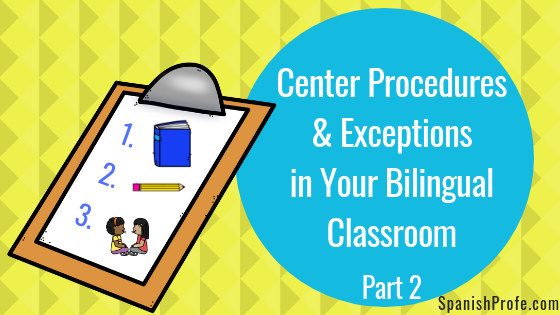
Your literacy or math centers will be a disaster and won’t work properly if you do not do (or think about) these things before you start centers in your bilingual classroom. Now if you read this article before the school year starts, that is great because you will have time to adequately plan. However, if you have started centers and they aren’t going well reflect on what expectations and procedures you have in place already and what you could change. It is never too late to improve how your centers are managed in your bilingual classroom.
This is article two in a series where we will talk about expectations and procedures about setting up centers (math or literacy) in your bilingual classroom. Read article one here, about the common concerns bilingual teachers have about setting up centers.
This is going to be a four or five part series on starting about maintaining productive centers in your Spanish immersion or bilingual classroom.
When planning centers it is very important to plan out each step of what will happen. Classrooms that have smooth running centers; have a set of clear expectation and procedures in place or else it wouldn’t be so “smooth”. You don’t want to spend a lot of time translating, prepping or planning awesome centers in Spanish and have your students confused, interrupting you or off task because you didn’t take enough time to set up and practice your expectations and procedures for this part of your day.
Though this list does not include every possible thing that you should consider; it will get your brain thinking about what have already considered or had in place and those things that you haven’t even thought about (yet).
1. Have clear expectations
What will students do at center? (How will they know what to do?)
What does it look like? Sound like?
What does the teacher do during centers?
What does the assistant/AE/EA/paraprofessional/AMITY do during centers?
What will students do 1st, 2nd, 3rd, etc.?
Will students turn in their work? When? How?
What happens if they don’t finish their work? Can they do it the next day/time they are in the center?
When will their work be checked?
How will they move or transition from station or station?
Which way will they move?
How will they clean up?
2. Have center procedures in place
What happens if a pencil breaks? Can they sharpen pencils?
What happens if a material runs out (paper, highlighter, etc.)?
What if there aren’t enough materials for everyone? Do they share?
Do they work alone or in pairs?
What happens if the student has a question?
Are they allowed to get up?
Is there a designated helper for supplies?
It there a designated Spanish or English helper or expert?
Can they go to the bathroom?
Can they ask the teacher or assistant for help? How to they ask for help?
3. Have supplies ready for students
Are there enough papers, pencils, cards, markers, etc?
If a supply runs out, what will happen?
As a teacher, all of these things need to be clear in your mind. After it is clear in your mind how you want things to run during centers time, then everything needs to be explicitly taught to your students.
Assume your students have no idea how to do anything and need very clean and clear instruction on how to be successful. Include visuals, have students practice doing it the right way (and maybe even the wrong way), make anchor charts for center time (usually a Y chart or a ‘Teacher does/students do’ work well).
It also helps to have a centerboard, times or something visual that students can refer to when working independently so they don’t have to talk (or interrupt) your small group instruction.
It may sound a bit silly but you need to take the time (A LOT OF TIME) in the first couple of weeks of school or even revisit your expectations whenever an issue arises that you have already talked about.
There are some bilingual teachers that skip over setting up with groups properly. These are the same teachers they spend the entire school year (or their entire teaching career) wondering:
Why their class doesn’t work quietly?
Why students keep walking around,
Why don’t my student know how to work independently?
Why don’t my students know where supplies are?
In part three of this series, we will talk about grouping and setting up centers.
Did you enjoy this article? Want tips and free resources in Spanish? Subscribe to Spanish Profe’s email list here.









